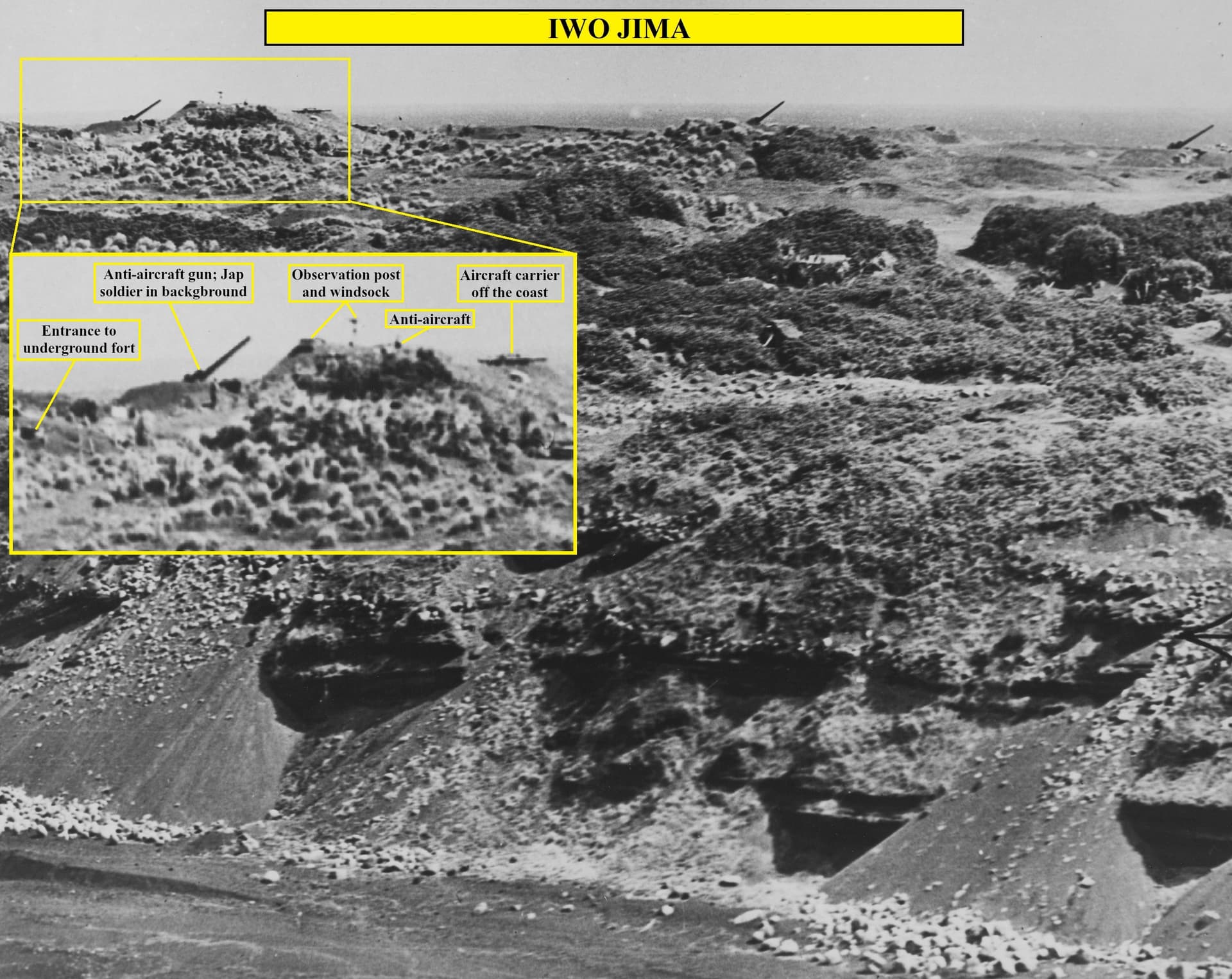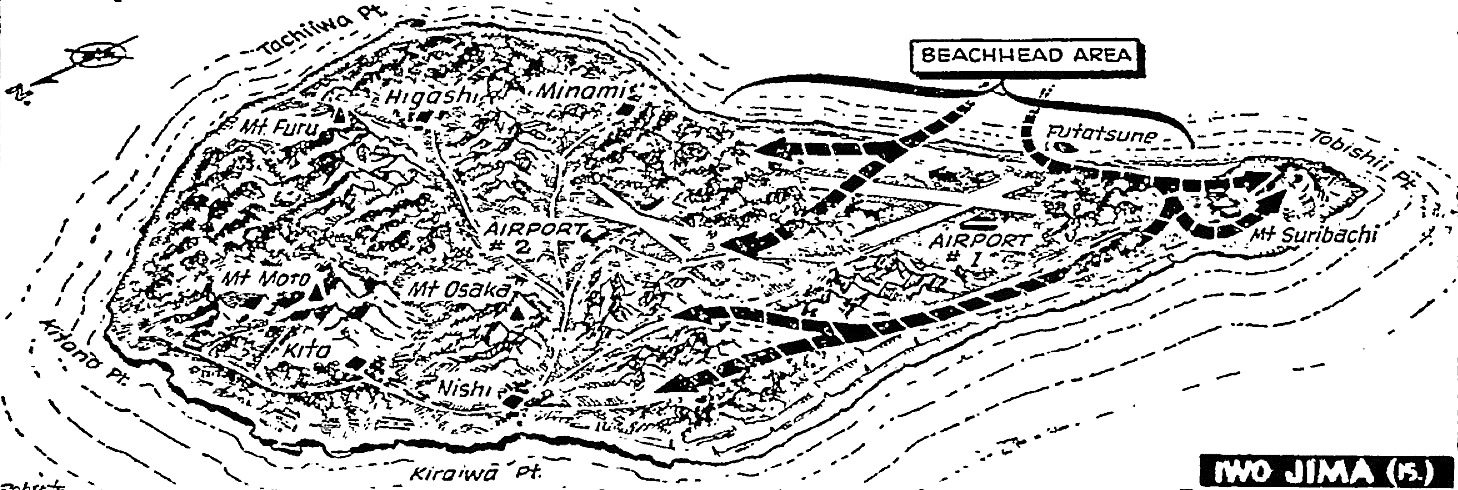The Pittsburgh Press (February 23, 1945)
MARINES MOP UP IWO PEAK
Yanks seize summit of Mt. Suribachi
Casualties 5,372, 3 every 2 minutes
Why the going is tough on Iwo

The Navy reconnaissance photo of Iwo, taken at daringly low level, gives a good idea of the forbidding ground over which U.S. Marines are battling. Large areas of the terrain were heavily dotted with pillboxes, sniper pits, and mines. Enlarged section shows some of the Jap installations.
GUAM (UP) – U.S. Marines captured Mt. Suribachi, volcanic peak commanding the bloody island of Iwo, and edged northward today in a new frontal drive against the central airfield.
Assault teams with flamethrowers were hunting out Japs hidden in several bypassed strongpoints on the slopes of the volcano.
A Navy communiqué raised the casualties for the first 58 hours of the Battle of Iwo, the toughest in the history of the Marine Corps, to 5,372. It estimated the American dead at 644, the wounded at 4,168, and missing at 560. The majority of the missing probably were dead.
Jap swimmers wiped out
A group of Japs swam around the western end of the Marine line across Iwo under cover of darkness last night and landed in the American rear. The Marines mopped them up after dawn.
Marines of the 28th Regiment scored the biggest tactical victory of the invasion when they scaled 554-foot Mt. Suribachi, at the southern tip of Iwo, and swarmed over the northern, eastern and western sides of the crater at noon.
From the summit of Suribachi, the Marines looked down on the entire island. Guns were being rushed to the peak to turn the tables on the Japs who from its heights had been plastering the Marines since H-Hour.

Last Japs on Mt. Suribachi were being mopped up today by U.S. Marines who had seized the summit of that highest Iwo Island peak. Marine spearheads battling toward the central or No. 2 airfield on Iwo made small gains.
‘Small gains’ reported
A communiqué reported “small gains” in the renewed drive on Iwo’s central or No. 2 airfield. The Marines, storming the fortifications before it, chopped their way slowly northward. They were advancing through heavy artillery and mortar fire.
For the fourth straight night, U.S. warships off Iwo shelled Jap positions. By daylight, U.S. planes from carriers joined in the bombardment.
The ships ringing the island were also pouring in a steady flow of supplies and equipment for the three Marine divisions fighting the hardest battle of the war in the Pacific.
Roads constructed
Engineers and construction crews had constructed several roads over the treacherous volcanic ash terraces, and the movement of supplies to the fighting zones was improving.
Adm. Chester W. Nimitz reviewed the situation on Iwo in his third communiqué of the day.
Three Americans fell dead or wounded every two minutes during the first 58 hours of battle on Iwo, Adm. Nimitz announced, but the Marines were killing two Japs for every American killed.
He said 1,222 Jap dead had been counted.
In the entire 76-hour battle on Tarawa, previously the bloodiest, 3,151 Marines were killed or wounded.
Some lose 25 percent
Front dispatches said 25 percent of one battalion in the first assault waves ashore on Iwo was killed or wounded in the first two hours after H-Hour. Twenty percent of a second battalion was felled.
The communiqué indicated that U.S. casualties had increased from 76 an hour for the first 48 hours of the invasion to 172 an hour – three a minute – during the next 10 hours, but it was more likely that a number of those reported in the late bulletin had actually been hit during the earlier
The 28th Marine Regiment reached the top of Mt. Suribachi 16 hours after surrounding the volcano. From its crest, the Americans for the first time can observe Jap movements around the central airfield atop a plateau.
Some Japs on peak
Many gun emplacements on Mt. Suribachi remained in Jap hands, however, and these will have to be stormed one by one. Tunnels and caves honeycomb the peak.
Jap troops counterattacked late yesterday against both flanks of the Marine spearhead pointed toward the central airdrome. Newly-landed artillery, backed up by the big guns of warships, appeared to have repulsed the assault from the left by 6 p.m., but no reports were available on the action on the right.
At last reports the Marines were still 200 yards from the airfield, though some units had bypassed its southern tip from the west.
Heavy rains also hampered the Marines.
A small group of Jap planes made a second attempt to attack U.S. warships off Iwo. But the raid was unsuccessful and fighters and anti-aircraft batteries shot down six planes.
In the first attempt at sunset Wednesday, some American fleet units were damaged, Adm. Nimitz said yesterday.
All sources agreed that the battle on Iwo was the toughest and bloodiest of the entire Pacific war. Vice Adm. John H. Hoover, commander of forward areas in the Central Pacific, said Saipan was “easy” by comparison.
Natural barriers
Besides being the heaviest fortified island yet encountered, Iwo possesses “tremendous natural barriers that also must be overcome,” he said in a broadcast on his return from the scene.
He said it might take two weeks “or even longer” to secure the island, depending on whether the Japs hole up to fight to the last or expend their forces in a suicidal banzai charge.
“Regardless of what tactics the Japs use,” he said, “we have the necessary manpower and equipment to insure an American victory.”
Once secured, Iwo immediately will be put into operation as an air base for attacks on Tokyo and other targets on the Jap homeland.
“You must remember that we can do in months what it takes the Japs years to accomplish.”
Beachhead imperiled
Adm. Hoover disclosed that the American beachhead on Iwo appeared doomed for a time on D-Day Monday. The Marines encountered little fire going ashore because the Japs thought the landing on the southeast beach was a feint, he said, but three hours later they swung mortars and howitzers into place.
Shells began knocking out U.S. tanks and causing casualties among the troops, he said.
He said:
It was a serious moment and for a while our invasion beach appeared doomed, but later that same day we discovered an area far to the south where we could penetrate to the southern airfield out of range of their heaviest gunfire.

